DACF Home → Bureaus & Programs → Maine Natural Areas Program → Communities, Plants, and Animals → Invasive Plants → Glossy Buckthorn
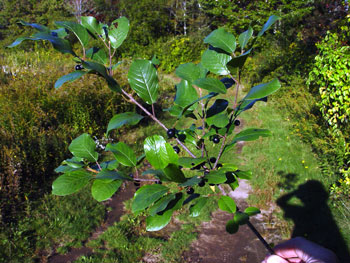 Glossy buckthorn stem with berries
Glossy buckthorn stem with berries
Glossy Buckthorn
Frangula alnus
2019 Status in Maine: Widespread. Severely Invasive.
Description: Perennial, deciduous, shrub or small tree, often multi-stemmed, can be single-trunked, to ~20' tall. Despite name, lacks thorns. Leaves: Simple, alternate, elliptical, 2-4" long, and sometimes glossy. Flowers: White-yellow, 5-petaled, small, in leaf axils, ~June in Maine (though some may bloom later). Fruit: Mature from green to red to purple-black in late summer/early fall, red and black fruit can co-occur on same plant. Bark: Mature twigs and stems have dark bark with raised, horizontal, light-colored lenticels. Roots: Red.
Native range: Europe, Northern Africa, Central Asia. How arrived in U.S.: As an ornamental, but also planted for wildlife and revegetation projects.
Reproduction: By seed. Fruits eaten and dispersed by birds and small mammals. Seeds viable at least two years.
Habitat: Forests, forest edges, many types wetlands. Moderately shade tolerant; more productive in sun. Tolerates wet to moist soils.
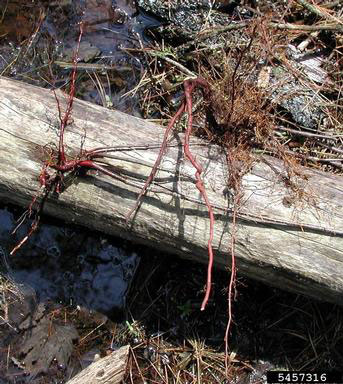 Glossy buckthorn roots, Leslie J. Mehrhoff, University of Connecticut, Bugwood.org
Glossy buckthorn roots, Leslie J. Mehrhoff, University of Connecticut, Bugwood.org
Similar native species: Cherries (Prunus spp.) have lenticels but scratched bark or twig has characteristic bitter almond smell and leaves are toothed. Alder-leaved buckthorn (Rhamnus alnifolia) has serrate leaf margins. Most dogwood shrubs (Swida spp.) have opposite leaves with wide bases, narrow tips, and paired veins that arch toward the tip.
Similar non-native species: Common buckthorn (Rhamnus cathartica) has sub-opposite, toothed leaves, and small woody spines at the ends of branches.
Documented Ecological Impacts
- Glossy buckthorn can negatively impact native plant and insect diversity and abundance, simplify vegetation structure, disrupt food webs, delay succession, and it is the alternate host for the fungus that causes oat rust disease and for the alfalfa mosaic virus. (Gucker, C.L. 2008. Frangula alnus. In: Fire Effects Information System. U.S. Department of Agriculture, Forest Service)
- Glossy buckthorn reduces native tree seedling density and diversity in white pine forests. Its extensive shallow root system may make it a strong below-ground competitor, and the increasing dominance of glossy buckthorn in New England pine forests may delay filling of canopy gaps. (Fagan, M.E. and D.R. Peart. 2004. Impact of the invasive shrub glossy buckthorn (Rhamnus frangula L.) on juvenile recruitment by canopy trees. Forest Ecology and Management 194:95-107)
- Birds and small mammals are major dispersal mechanisms for glossy buckthorn. The laxative effect of the fruits facilitates its spread. (Michigan Natural Features Inventory. 2012. Glossy buckthorn fact sheet. Michigan Department of Natural Resource)
- The Maine Natural Areas Program has documented glossy buckthorn in high quality wetlands, of concern because it can degrate wildlife habitat and the wetlands' natural benefits to humans.
Fact Sheets and Identification Links
- Michigan DNR Best Control Practices for Glossy Buckthorn
- Outsmart Project, Massachusetts, Identification Video (1:50)
- Go Botany page for Frangula alnus
Control Methods
Small plants and seedlings may be pulled up by the roots when soil is moist; larger plants can be cut, but re-sprouting will occur.* Persistent cutting or mowing multiple times during the growing season over several years may kill the plant, but diligence is required (at least 3x/yr for 3 yrs is suggested). Mowing can prevent seedlings from establishing. Herbicides† are effective as foliar applications (triclopyr or glyphosate solution), cut-stump applications (glyphosate or triclopyr solution applied immediately after cutting except in early spring), or basal bark application (for stems <6" diameter, triclopyr ester in oil). Special rules apply to herbicide use in or near wetlands and water bodies - consult the Maine Board of Pesticides Control.
* Correctly dispose of all plant parts↵ † Follow all label directions when using herbicides↵Control Technique Video Demonstrations
- Coon Rapids, Minnesota (6:29), hand pulling, weed wrench, stump cut and herbicide
- Ontario (5:00), lever/wrench, girdling, proper disposal and restoration
- Forest Restorations, Minnesota (2:30), hand tools: lever/wrench
Please email invasives.mnap@maine.gov if you have questions about invasive species in Maine
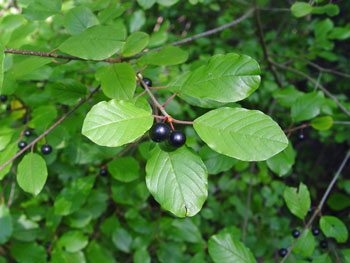 Glossy buckthorn fruit and leaves
Glossy buckthorn fruit and leaves
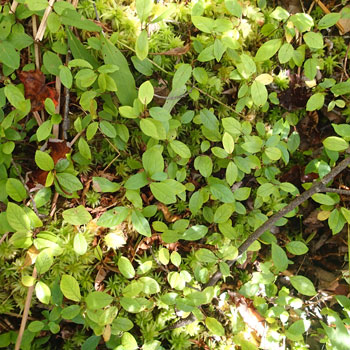 Glossy buckthorn seedlings
Glossy buckthorn seedlings
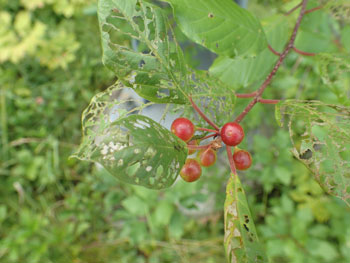 Glossy buckthorn unripe fruit and leaf damage from Japanese beetles
Glossy buckthorn unripe fruit and leaf damage from Japanese beetles